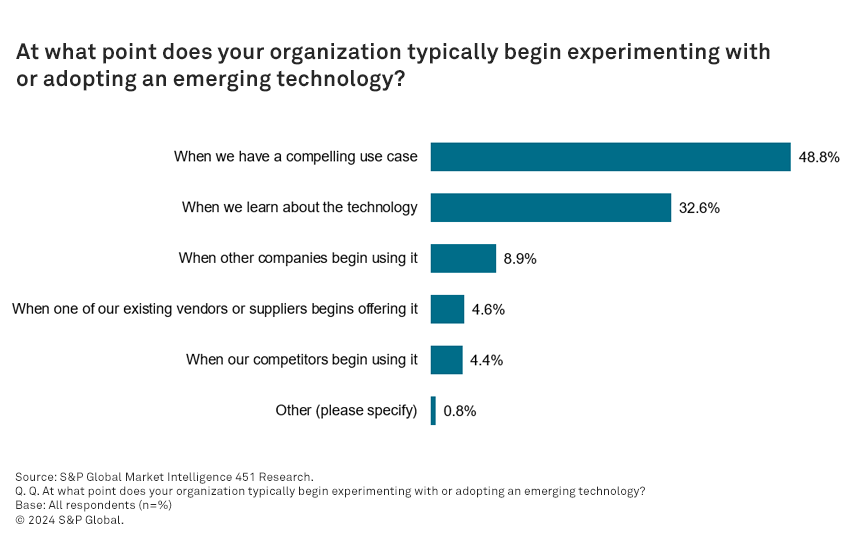
Source: Jasmin Merdan/Moment via Getty Images.
In today’s rapidly evolving technological landscape, organizations are constantly seeking ways to maintain and improve operations while supporting growth. To achieve this, organizations are increasingly investing in emerging technologies that have the potential to significantly impact future operations. According to a recent survey conducted by 451 Research, a part of S&P Global Market Intelligence, generative AI has emerged, surpassing security-focused AI functions in terms of expected impact and investment intent.
The survey was fielded with approximately 1,200 IT decision-makers and revealed that a significant proportion of organizations are willing to start experimenting with new technologies even before their practical uses are fully apparent. Nearly half (49%) of the respondent organizations stated that they typically begin experimenting with or adopting emerging technologies once they have a compelling use case. Notably, one-third (33%) of organizations start working with emerging tech as soon as they learn about it. This proactive approach to technology adoption is particularly prominent among younger organizations and software/IT services organizations, highlighting the importance of staying ahead of the curve.

Intent to spend and expected impact
Unsurprisingly, the intent to spend on a given technology correlates strongly with its expected impact on the organization in the coming years. The survey found a highly linear relationship between interest in investing in a technology today and its expected impact on the organization. Generative AI emerged as the top technology in both categories, with organizations recognizing its transformative potential. Security-focused AI functions, while still important, have been overtaken by generative AI in terms of both expected impact and investment intent.
Autonomous vehicles and machines: A distinct lag in impact and investment
Autonomous vehicle and machine technologies exhibit a significant gap in both impact and investment compared with other emerging technologies, even those ranked slightly higher. However, it is important to note that these technologies have specific use cases that cater to a limited range of industries. As a result, their overall impact is naturally constrained and may not have a widespread effect across various types of organizations.
Organizations’ preferred choice for investing in emerging technologies
More than half of organizations (58%) opt to collaborate with their existing vendors when making investments in emerging technologies. Working with consultants (47%) and seeking out emerging vendors (43%) are also popular approaches. Engaging with open-source communities ranks lower on the list (32%), indicating that only a small number of organizations consider utilizing in-house resources for do-it-yourself projects. However, organizations younger than 10 years old (44%) are more inclined to leverage open-source communities compared with their older counterparts (28%).
Conclusion
As the IT landscape continues to evolve, IT decision-makers must stay abreast of emerging technologies that have the potential to reshape their organizations. Generative AI and computer vision have emerged as critical technologies, with high expected impact and investment intent. By embracing these technologies and adopting a proactive approach to technology adoption, organizations can unlock new possibilities, improve operational efficiency and drive innovation. The future belongs to those who dare to explore the transformative potential of emerging technologies.
Do you have your finger on the pulse of tech trends? Join the 451 Alliance for exclusive research content on industry-wide IT advancements. Do I qualify?
Want insights on consumer technology trends delivered to your inbox? Join the 451 Alliance.
This content may be AI-assisted and is composed, reviewed, edited and approved by S&P Global in accordance with our Terms of Service.

